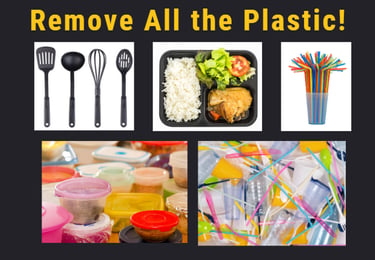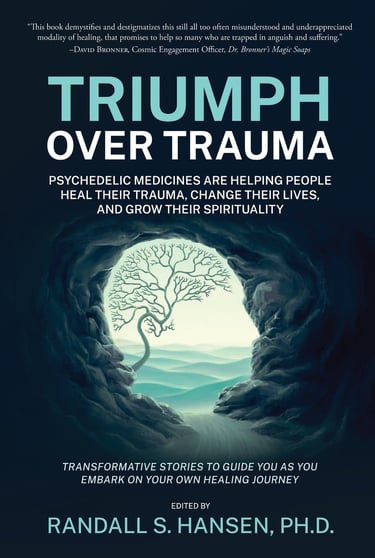Get the (Micro) Plastic Out of Your Home!
We, the people of the world, love our plastic. Worldwide, plastic production continues to rise and is now up to a trillion pounds a year. Worse, according to the Organisation for Economic Cooperation and Development, plastic waste is expected to triple by 2060, with around half ending up in landfills and less than a fifth recycled.
There is practically nowhere on Earth that plastic waste has not been discovered.
And while the plastic waste we see floating in the ocean or mounds of plastics suffocating some developing countries are horrible images of the amount of plastic waste produced, the scarier and less discussed issue is the amount of microplastics that are in the air, water, soil – and in our foods and within our bodies and bloodstreams.
Some experts are saying we are in a microplastics health crisis, especially as the amount of microplastics continues to rise rapidly and studies show microplastics affecting our blood vessels (possibly increasing the blocking of arteries). More recently, microplastics have been seen in several human organs, including our lungs and brains.
No one is quite sure of the true impact of microplastics, but it is clear that if you have inflammation in your body – from eating the Standard American Diet of ultra-processed foods and beverages – the microplastics can enhance the dangers of chronic inflammation, which is why some researchers are saying microplastics are increasing the number of heart attacks and strokes.
Microplastics are pieces of plastic debris under five millimeters in length. These microplastic particles are so small that they often pass right through air and water filtration systems, after which we unknowingly ingest them. We’re also eating them with our food, with microplastics found in fruits and vegetables, fish, and meats.
How bad is the situation? Projections show that the average person is eating, drinking, touching, and breathing anywhere from 80,000 to 211,000 microplastic particles annually. Microplastics are tiny pieces of plastic that are less than five millimeters long in at least three dimensions.
Adding the even smaller nanoparticles of plastics, and some studies show people are consuming 22 MILLION particles annually.
But microplastics are tiny, right? To put it in another way, researchers estimate that the average person is consuming about a credit-card-sized amount of microplastics every week.
What can you do about it? You can start by reducing the microplastics circulating within your own home.
Removing Plastics and Microplastic Contamination
Once again, the concept of convenience has caused havoc; in this case, it’s the convenience of using plastics over heavier materials such as glass or metal.
While we can’t control the microplastics we are exposed to outside our homes, we can do a much better job of reducing them in our homes.
A Call to Action: Remove/Replace These Items
1. Nonstick cookware. A recent study found that non-stick cookware can release microplastics into food during food preparation. Another study identified that Teflon-coated cookware can release millions of microplastic particles into the food if the pan has any cracks or scrapes in the coating. Replace all older “non-stick” pots and pans with glass, metal, or ceramic.
2. Plastic Utensils. Most people know that plastic forks and knives are wasteful and unnecessary, but probably every home has at least one plastic flipper, spatula, pasta server, or soup ladle. Besides the questionable use of recycled plastic (which may be contaminated) for these items, plastic utensils release microplastics into your food, especially when used with hot foods. Replace these plastic utensils with metal, wood, or silicone materials.
3. Plastic Tubs, Bowls, and Containers. These items are ubiquitous in households, whether from frozen dinners and soups or takeout food purchases. Amazingly, there is even a food service delivery that uses plastic and touts that all customers need to do is “reheat it in the microwave.” These items release microplastics into your food when heated or washed. Replace these items with glass or stoneware containers.
4. Plastic Straws. Most of the talk around plastic straws has centered on the plastic pollution epidemic, but as you may have already guessed, straws release microplastics and nanoplastics – affecting the user, but as these get deposited in waterways, they release these particles into the water. Happily, there are many manufacturers offering alternatives made from paper, steel, glass, and wood.
5. Plastic Water Bottles. If you’re buying water in individual bottles, you are drinking and inhaling microplastics, especially if you leave them in a hot car. In one study, researchers found that, on average, a liter of bottled water included about 240,000 tiny pieces of plastic, with about 90 percent of these plastic fragments being nanoplastics. Healthier alternatives involve buying a reusable water bottle that is made from glass, ceramic, silicone, aluminum, or stainless steel.
6. Plastic Cutting Boards. Studies show that every time a person cuts food on a plastic cutting board, especially those made from polyethylene and polypropylene, it releases microplastics. While there are some issues with keeping wood cutting boards clean from bacteria, most experts agree that these are the safest to use – especially in light of the microplastics.
7. Tea Bags. It may be hard to believe, but many tea bags are made with polypropylene, a thermoplastic polymer, and studies show that when exposed to the hot water, tea bags can release billions of microplastic and nanoplastic particles into the tea water. Not all tea bags are made from plastic, so when shopping for tea, look for labels that say "plastic-free," "biodegradable" or "compostable." Of course, the safest option is to switch to loose-leaf tea stored in a metal container.
8. Cosmetics and Laundry Products. While there has been work in this area, researchers say that about 90 percent of all cosmetic products contain microplastics, which are added for viscosity, color, and glitter/sparkle. Many laundry detergents include “microbeads.” When these products are rinsed off in the shower or washer, plastic particles mostly go down the drain, into wastewater and eventually back into the drinking water.
9. Artificial Fabric. Studies show that synthetic material, especially loosely woven synthetic material from polyester or nylon, shed microplastics when washed. This means all clothing, bedding, and fabrics made from artificial materials are sending microplastics down the drain and into wastewater systems and eventually back into our drinking water. The best solution is to return to buying materials made from natural fibers (cotton, linen, wool) whenever possible.
Final Thoughts on Avoiding Microplastics at Home
If you care about your health, and especially if you have children living in your home, it is imperative to start limiting your exposure to microplastics and nanoplastics in your home by moving forward with some of the suggestions in this article.
One final suggestion. Your faucet poses another possible microplastic hazard. Most experts recommend adding a strong water filtration system – whether that is directly on your whole house, on your kitchen faucet, or through the use of a water pitcher designed to filter out microplastics.
Plastics have been an amazing tool of convenience, but once again, we are all paying the price for that convenience.
Want more specifics? See the next section, which contains multiple microplastic sources.
Additional Microplastic Sources
New Review Highlights Human Health Risks from Microplastic Exposure
7 Places Microplastics Are Hiding in Your Kitchen and Easy Swaps to Get Them Out
Health Risks Posed by Microplastics in Tea Bags: Microplastic Pollution – a Truly Global Problem
Can Cookware Be Toxic? What to Know and How to Choose Pots and Pans
12 Best Non-Plastic, Non-Toxic Food Storage Containers to Keep Your Food Fresh
30 Alternatives to Plastic Straws to Skip Single-Use Plastic
Here’s Why You Should Probably Stop Using Your Plastic Cutting Board
Breathing Plastic: The Health Impacts of Invisible Plastics in the Air
The Top 5 Sources of Microplastics at Home and How to Avoid Them
Dr. Randall Hansen is an advocate, educator, mentor, ethicist, and thought-leader... helping the world heal from past trauma. He is founder and CEO of EmpoweringSites.com, a network of empowering and transformative Websites, including EmpoweringAdvice.com.
He is the author of the groundbreaking Triumph Over Trauma: Psychedelic Medicines are Helping People Heal Their Trauma, Change Their Lives, and Grow Their Spirituality and the well-received HEAL! Wholeistic Practices to Help Clear Your Trauma, Heal Yourself, and Live Your Best Life.
His latest book is a true game-changer: The HEALing Revolution Diet: A Science-based Approach to Heal Your Gut, Reverse Chronic Illnesses, Lose Weight, Clear Your Mind, and Increase Longevity.
Dr. Hansen's focus and advocacy center around true healing ... healing that results in being able to live an authentic life filled with peace, joy, love. Learn more by visiting his personal Website, RandallSHansen.com. You can also check out Dr. Randall Hansen on LinkedIn.








